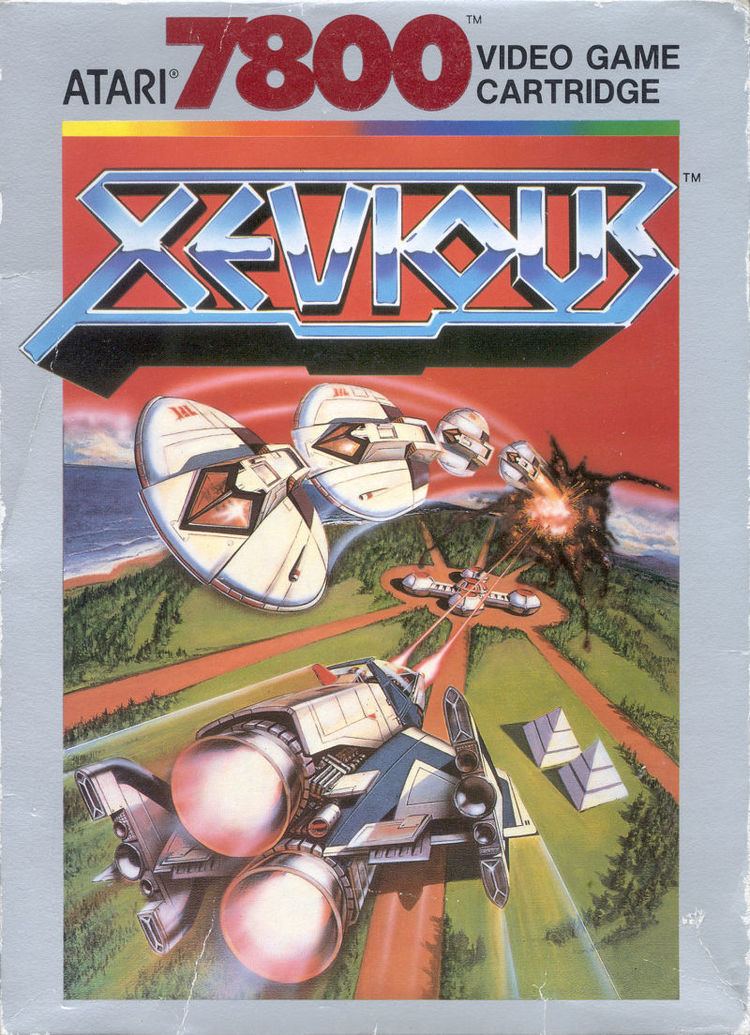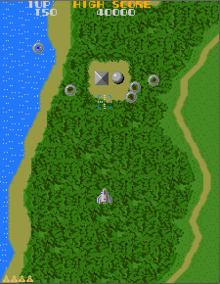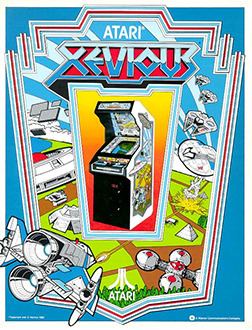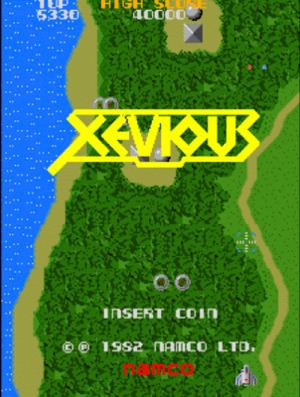7.6 /10 1 Votes
7.3/10 GameSpot Initial release date December 1982 Cabinet Upright | Composer(s) Yuriko Keino Designer Masanobu Endō | |||||||||||||||||||||||||||||||||
 | ||||||||||||||||||||||||||||||||||
Genre(s) Vertically scrolling shooter Mode(s) Up to 2 players, alternating turns CPU 3x ZiLOG Z80 @ 3.072 MHz Similar Mappy, Galaga, Dig Dug, Galaxian, The Tower of Druaga | ||||||||||||||||||||||||||||||||||
Arcade game xevious 1982 namco
Xevious (ゼビウス, Zebiusu) is a vertical scrolling shooter arcade game that was released by Namco in December 1982. It runs on Namco Galaga hardware, and was designed by Masanobu Endō (who later created The Tower of Druaga). In North America, the game was manufactured and distributed by Atari, Inc..
Contents
- Arcade game xevious 1982 namco
- Xevious torolic h241229 game vamos arcade i
- Gameplay
- Story
- History
- Series
- Other media
- Ports
- Differences between Japanese and North American versions
- References
Xevious torolic h241229 game vamos arcade i
Gameplay

The player must use an 8-way joystick to pilot a combat aircraft called a Solvalou, which is armed with a forward-firing Zapper for aerial targets and a Blaster which fires an unlimited supply of air-to-surface bombs for ground targets. The game, presumably set in Peru, was notable for the varied terrain below, which included forests, airstrips, enemy bases, and mysterious Nazca Lines-like drawings on the ground.

There are various aerial enemy aircraft which fire relatively slow-moving bullets at the player, as well as (presumably unpiloted) fast-moving projectiles and exploding black spheres. Ground enemies are a combination of stationary bases and moving vehicles, most of which also fire slow-moving bullets at the player. Giant floating Andor Genesis motherships appear in certain areas; these must be defeated by knocking out their cores, and are considered one of the first level bosses to be incorporated into a video game.

The game scrolls through 16 areas, looping back to Area 7 after Area 16. The Solvalou continually advances over varying terrain, and the boundaries between areas are marked only by dense forests being flown over. If the player dies, play will normally resume from the start of the area - but if the player has completed at least 70% of the current area before dying, play will resume from the start of the next area instead. As the Solvalou continuously flies forward, it is possible to advance without defeating any enemies.
Xevious has hidden bonuses which are not mentioned in the instructions, but can be revealed by performing a secret maneuver. Among these is the "special flag" which first appeared in Rally-X. In Xevious the flag gives the player an extra life when collected, something carried over to subsequent Namco games.
Story
Xevious tells the story of the fight between humankind and the biocomputer GAMP, which controls the alien forces of planet Xevious. It turns out that the Xevious inhabitants are originally from Earth, and GAMP (General Artificial Matrix Producer) is the product of an ancient civilization that prospered on earth a hundred thousand years ago. During this golden age, the Gamps were human clones used in heavy labor, until they rebelled against their own creators. In order to survive the upcoming Ice Age, they planned to leave earth and migrate in search of a new homeland. They finally selected seven planets that were likely suitable to human life.
Right before the departure, a group of humans rebelled and decided to stay on the earth anyway. It is from here that a thousand years after the leaving of the Gamps, the brave pilot Mu and his android companion Eve decided to travel to Xevious (literally, the fourth planet) to avoid glaciation. They would not receive a warm welcome from their ancestors, though: captured and imprisoned, they discovered that the Xevians were actually planning a massive comeback on the Earth.
Fast forward to our days: all above the Earth's surface, and near the ancient civilization remains, giant artifacts suddenly emerge from the soil and activate: they are SOL towers, buried underground and inactive for eons, now responding to GAMP's orders. The invasion has begun: it is now that, with perfect timing, Mu, Eve, and Mio Veetha, a Xevian who opposes the Gamp's regime and freed our duo from imprisonment, are back on the Earth on their Solvalou ship and ready to fight Gamp's army. Meanwhile, archaeologists Susan Meyer and Akira Sayaka discovered that the Nazca lines could be hiding an ancient weapon that may be used to counterattack Gamp's army.
History
Xevious was an early, but not the first, vertically scrolling shooter, and greatly influenced games in this genre. The graphics were revolutionary for their time, and characters are rendered with remarkable clarity and effect through careful use of shades of gray and palette-shifting.
In 1983, Xevious was the first arcade game to have a television commercial aired for it for the North American market. Atari promoted the game with the slogan "Are you devious enough to beat Xevious?" and closed the commercial with a tag line branding it "the arcade game you can't play at home."
Popular musicians Haruomi Hosono (Yellow Magic Orchestra) and Keisuke Kuwata (Southern All Stars) were known to be fans of the game, and the former produced an album of music from Namco video-games, with Xevious as its centerpiece. A follow-up 12" single featured in its liner notes an entire science-fiction short story by Endō, set in the world of Xevious, with even a rudimentary fictional language. The theme music from Xevious was used during certain segments of the video arcade game-based television game show Starcade.
According to Namco Museum DS, a three-part novel was written about Xevious entitled "Fardraut". However, not much is known about the book, implying that it was never even released. According to the game, some backgrounds, characters, events and even sounds were inspired by the book.
Series
Xevious spawned several arcade sequels, updates, and even a spin-off:
Other media
Ports
Xevious has been ported to many other formats, including the Atari 7800, NEC PC Engine, and Nintendo Entertainment System (as Xevious: The Avenger) game consoles, as well as the MSX, ZX Spectrum, Commodore 64, Amstrad CPC, Apple II, Sharp X68000 and Atari ST home computers. A version named Xevious Millennium was released for the Nintendo Game Boy handheld console.
The game has also been included in a number of classic arcade game compilations for consoles and PC, including Namco Museum Volume 2 for the original PlayStation in 1996, Microsoft Revenge of Arcade for the PC in 1998, Namco Museum 50th Anniversary for the Xbox, PlayStation 2, Nintendo GameCube, and PC in 2005 (but was not included in the scaled-down Game Boy Advance version of Namco Museum 50th Anniversary), Namco Museum Battle Collection for the PlayStation Portable in 2005, Namco Museum DS for the Nintendo DS in 2007, Namco Museum Remix for the Wii in 2007, and Namco Museum Essentials for the PlayStation 3 in 2009. In 2004, the game was also ported to the plug-n-play format as part of the Ms. Pac-Man TV Game arcade compilation, released by Jakks Pacific and developed by HotGen Studios.
The NES version of the game was repackaged for Game Boy Advance in 2004 as part of the Classic NES Series, was included as an unlockable bonus game in Star Fox: Assault in 2005, and was released for the Virtual Console on January 15, 2007 for the Wii and May 9, 2013 for the Wii U.
In 2005, Namco released the game on the mobile platform for cellphones. It was released on Xbox Live Arcade on May 23, 2007.
In 2006 Xevious was released in the Let's! TV play classic series along with a sequel called Xevious Scramble Mission that utilised the same gameplay and engine.
Paired releases with Super Xevious include Namco Classic Collection Vol. 1, Namco Museum DS and Xevious 3D/G+ for the original PlayStation.
Atari 2600 and Atari 5200 ports were being developed by Atari, Inc. in 1984, but were never released.
This game has also been released as part of the Pac-Man's Arcade Party arcade machine in 2010.
3D Classics: Xevious is a Nintendo 3DS port of this game with 3D effects added to separate all of the objects in the air and everything on ground, and the port takes advantage of the 3DS's whole top screen instead of it being limited to the game's original resolution (with moving clouds added on to the sides), it's available for download on the Nintendo eShop for $5.99. It was released in Japan in June 2011 and in North America, Europe and Australia in July 2011.
Differences between Japanese and North American versions
The names appearing by default in the Japanese version's high-score list are pseudonyms of the game and sound designers. The North American version only allowed three characters for high-score names.
The Zapper and Blaster buttons were reversed between the Japanese and North American arcade versions.
